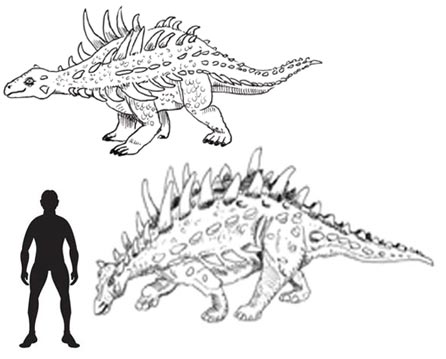Summarising the Differences between Polacanthus and Hylaeosaurus
Everything Dinosaur team membres discuss the armoured dinosaurs Polacanthus and Hylaeosaurus.
Hylaeosaurus was the first armoured dinosaur to be discovered. It was named and described by the famous English naturalist and scientist Gideon Mantell in 1833. Known from only two partial specimens, although fragmentary fossils from the Isle of Wight and France have been ascribed to this genus, Hylaeosaurus was a founder member of the Dinosauria when this new taxonomic description was postulated by Richard Owen (later Sir Richard Owen). The holotype of Hylaeosaurus is associated with the Wealden Formation of West Sussex (England).
Polacanthus and Hylaeosaurus
To view scale models of armoured dinosaurs and other prehistoric creatures: CollectA Deluxe Prehistoric Life Models.
Polacanthus is another genus of armoured dinosaur, associated with the United Kingdom, two species are recognised and the first fossils of this particular thyreophoran were found on the Isle of Wight. These fossils were found some thirty years after Hylaeosaurus had been formerly named and described.
A Polacanthus Dinosaur Model
Picture credit: Everything Dinosaur
To view the range of Papo dinosaurs: Papo Prehistoric Animals.
It has been suggested that P. foxii and Hylaeosaurus armatus were roughly the same size, at around 5 metres in length and there has been some confusion between these two genera. This is not helped by the paucity of the fossil record when it comes to English armoured dinosaurs (the splendid Scelidosaurus fossil discovered by David Sole being an exception).
It has been suggested that Polacanthus and Hylaeosaurus are actually the same genus. If this is the case then Hylaeosaurus would be the senior synonym. The best fossils of these animals are the front elements and limbs of Hylaeosaurus and the hind quarters of Polacanthus. This means that scientists have little fossil material from either genus to directly compare. As far as we know, no skull material ascribed to the Polacanthus genus has ever been found, thus compounding the problem between the two genera.
Polacanthus foxii was formerly named and described by Owen in 1865, so the debate over the rights and wrongs of these two scientific descriptions has been ongoing for over 140 years, with precious little new evidence from fossil discoveries having been found to help differentiate between the two.
Illustrations of Polacanthus (top) and Hylaeosaurus (bottom)

Picture credit: Everything Dinosaur
However, Hylaeosaurus seems to be stratigraphically older (Valanginian faunal stage as opposed to the Barremian faunal stage for Polacanthus) and because the two genera appear to possess differing arrangements of dermal armour, different types of armour as well, they were probably distinct. Both may have been low browsers and filled the same environmental niche but it is now largely agreed that the fossils found of these two dinosaurs are not conspecific (belong to a single species).
In Polacanthus the scapulocoracoid (bones making up the shoulder girdle) are fused, this does not seem to be the case with Hylaeosaurus. The shape of the tibia (shin bone) may also be different and there has been no evidence found of a sacral shield of fused scutes (armour plates) with Hylaeosaurus.
Armoured Dinosaur Models
There are a large number of armoured dinosaurs in stock at Everything Dinosaur, take a look at the models section on our award-winning website: Dinosaur and Prehistoric Animal Models.







Leave A Comment